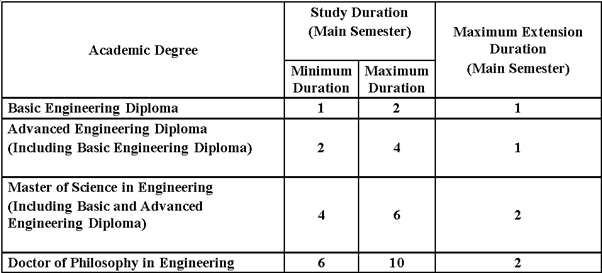On June 28, 2012, the first graduate studies bylaw at the Faculty of Engineering, Shubra, was approved under the credit hour system. This bylaw adhered to the necessary regulations for preparing such documents at the time, while the faculty also established mechanisms for implementation and the fundamental rules governing study at the faculty. The revised bylaw, approved on February 7, 2016, also under the credit hour system, introduced the Master of Engineering degree (coursework only, without a thesis). However, this degree remained less attractive because it did not allow holders to register for a Doctor of Philosophy (Ph.D.) program.
Given the significant advancements in engineering sciences, many academic programs now include multiple specializations or tracks, whether combining different engineering disciplines or integrating engineering with non-engineering disciplines. This necessitated the inclusion of rules governing the admission requirements and study protocols for interdisciplinary programs. With the approval of the reference framework for designing graduate programs in engineering faculties by the Engineering Studies Sector Committee on May 18, 2020, the Faculty of Engineering, Shubra, at Benha University, has prepared a graduate studies bylaw that aligns with the rules and regulations outlined in this framework.
This bylaw was designed to ensure consistency with international academic systems, facilitating mutual recognition and the mobility of students between Egyptian and non-Egyptian universities. Furthermore, the research trends in graduate studies have been updated to align with local, regional, and global developments. The current bylaw standardizes the names of graduate programs (Diploma/Master/Doctorate) and includes the rules and regulations governing admission and study across various programs. It aims to provide practical solutions to the following challenges:
- Confusion between the qualifying diploma required for graduate studies (for those without the necessary cumulative GPA for direct registration) and the advanced engineering diploma.
- Lack of recognition of the master's degree coursework as an independent academic qualification without completing the master's thesis.
- Extended timeframes for completing a master’s degree, conflicting with the primary goal of adding modern academic and research expertise.
- Absence of structured guidelines for alternative methods of obtaining a Ph.D., such as the cumulative approach, which involves preparing and publishing a set number of high-ranking research papers followed by compiling them into a dissertation at the end of the research.
To address these challenges comprehensively, educational programs have been designed to align with the National Academic Standards issued by the Egyptian Accreditation and Quality Assurance Authority. These programs are characterized by their flexibility to accommodate diversity and excellence and reflect the faculty's capabilities and expertise. This ensures a minimum level of alignment between the bylaws and programs of engineering faculties across different universities. Additionally, mechanisms for evaluating academic degrees have been developed to align with modern global trends. The bylaw also provides a detailed framework for conducting research at the master's and doctoral levels, ensuring continuous assessment and monitoring of research progress. Below is a brief summary of the faculty's vision, mission, strategic objectives, and historical background.
The Academic Degrees Granted by the Benha University Council to Postgraduate Students Based on the Recommendation of the Faculty of Engineering at Shoubra Council.
-
Advanced Diploma in Engineering
-
Master of Science (M.Sc.) in Engineering
-
Doctor of Philosophy (Ph.D.) in Engineering
Duration of Study for Various Degrees

- The specified duration is calculated from the date of the student’s registration for the academic degree. Suspension semesters are not included within the allowed periods.
Flowchart of the Steps to Obtain the Advanced Diploma in Engineering and the Master of Science in Engineering

Flowchart Illustrating the Steps to Obtain a PhD in Engineering
